Great Panjandrum self-propelled engineering munition (UK)
Fearing the possible landing of the enemy in continental Europe, Nazi Germany for a long time built numerous objects so-called. Atlantic Wall. Sections of the coast hundreds of kilometers in length were covered with firing points and bunkers, as well as various explosive and other barriers. Having received information about the existence of such coast protection, the command of the countries of the anti-Hitler coalition was forced to look for new ways to overcome obstacles that could ensure the passage of troops through all existing barriers.
Not later than the middle of 1943, the special organization DMWD (Department of Miscellaneous Weapons Development), which was responsible for creating new unusual models of equipment and weapons, received another task. It should be noted that DMWD specialists were usually entrusted with the development of projects that were not the responsibility of other departments of the military department. As a result, this organization was often given very original tasks, followed by no less unusual results. The Great Panjandrum project was a clear confirmation of this rule.
The command wanted to get some means of combating the concrete walls that stood in the way of the troops. This product, with the help of an explosion, was supposed to make passages in walls up to 3 m high and more than 2 m thick. At the same time, the passage dimensions should correspond to the dimensions of the available tanks. An explosive charge of the required power should be delivered to the target without the participation of a person or any equipment. A possible carrier of engineering weapons should have been the existing landing ships and boats.
Several DMWD designers, including Neville Shute Norvey, who already had experience in creating unusual designs, took up the task. First of all, he calculated the required dimensions of the warhead of a new weapon. For the destruction of a concrete wall with given parameters and the formation of a passage for a British tank, more than 1 tons of explosives were required. Such a large charge made special demands on the means of its delivery. The intended method of application, launching from ships and the situation on the beaches also did not facilitate the development.
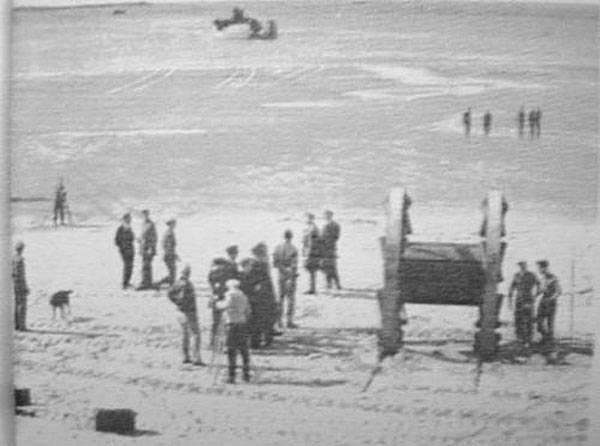
Tests, 12 Nov. 1943 g. Photo by Wikimedia Commons
It was proposed and reviewed several versions of the design of the delivery system, after which they chose the least complex and most appropriate to the existing technical specifications. Strange as it may seem, DMWD experts decided to deliver the warhead from the landing craft to the target using a special wheel system with solid-propellant jet engines. Truly harsh times require harsh decisions.
At this stage, the project received the working designation Great Panjandrum, which can be translated into Russian as “Big Shot” in the sense of “very important person”. The name of the product itself was borrowed from the illustrated book of The Great Panjandrum Himself, authored by the writer Samuel Foote and the artist Randolph Caldecott. The reasons for this choice are unknown. Apparently, the staff of DMWD believed that the new weapon would have the same effect as the appearance of the title character of the book. You can also recall the fact that the original work belonged to the genre of literature of the absurd.
Of great interest is the issue of classification of the Great Panjandrum product. According to its purpose, it was supposed to be a typical engineering disruptive charge necessary for making passes in the enemy’s barriers. However, having your own undercarriage and powerplant allows you to adjust this definition. Thus, the “Big Cone” can be called self-propelled engineering ammunition. This weapon simply does not fit into the existing classification without its addition with new categories.

The launch carrier is ready to launch. Newsreel from Imperial War Museum / Iwm.org.uk
From the point of view of design, the prospective ammunition was to be a pair of wheels, instead of the axis of which the body was used for explosives. The elements of the propulsion system responsible for the movement were placed directly on the wheels. The authors of the project estimated that the image they proposed would allow the product to reach speeds of up to 60 miles per hour (97 km / h), cover a distance of several miles and explode gaps in the concrete barriers with an explosion.
The main element of the Great Panjandrum product design, connecting together all the other units, was the central building. It was made in the form of a cylinder with a diameter of about 1 m and a height of the order of 2 m. At the ends of the cylinder wall there were expanding sections with holes, by means of which round caps were to be mounted on bolts. In order to avoid unpleasant incidents, there were arrows on the end covers showing the direction of rotation of the product during movement. It was possible to place a ton of explosive inside the cylindrical body, as required by preliminary calculations. The charge received a contact fuse, triggered by abruptly stopping the product due to hitting the target.
On the wall of the central body with equal intervals nine plates of small height were fixed. Near the butt of the hull the plate was connected with a wheel spoke with the help of a kerchief corner. Nine wooden or metal knitting needles about 1 m long were provided near each end of the hull. The wheel rim with a diameter of just over 3 m could be made of wood or metal. With the needles rim connected with a set of reinforcing elements. In the future, this design of the wheels was repeatedly refined, but the overall architecture, implying a rigid connection between the hull, the spokes and the rim, did not change.
The product Great Panjandrum had two wheels of similar design, mounted on the ends of the central building. Thus, outwardly, it looked like a coil. Due to the rigid coupling of the wheels and the housing, the whole product had to be rotated when rolling. No hinges etc. devices were not used due to the need to simplify the design.
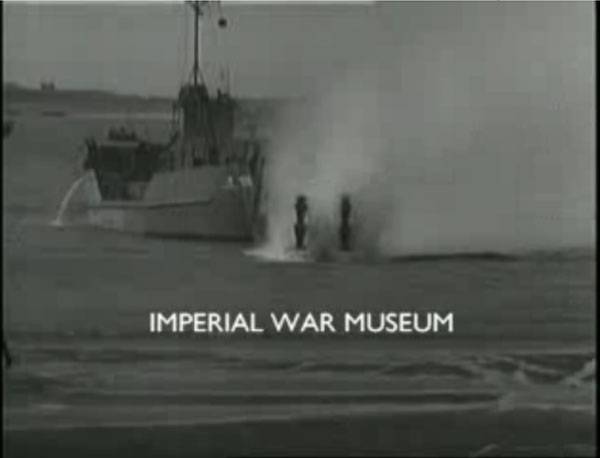
The big shot came off the carrier. Newsreel from Imperial War Museum / Iwm.org.uk
The proposed architecture of the engineering ammunition did not leave any free volumes, and the requirement to simplify the design did not allow equipping it with the power plant of the usual types. For this reason, N.Sh. Norway and his colleagues used a very original - albeit more than non-standard - way to move. On the rim of each wheel there were nine sets of devices for attaching solid rocket motors with a cordite charge weighing 9,1 kg each. Exactly at half the distance between the spokes there was a hard stop, with which the front ends of two engines were connected. The rear ends with nozzles were fixed on a diamond-shaped frame and were set apart in different directions so that the flame and smoke did not fall on the rim of the wheel. Each wheel thus had nine sets with 18 engines. The propulsion system as a whole, respectively, consisted of 36 products, which made it possible to obtain a sufficiently high thrust. All engines were connected to a common electric ignition system connected to an external operator console.
The product in the combat position had a length and height of about 3 m - according to the diameter of the wheels. The width slightly exceeded 2 m. The mass of the fully equipped “Big Cones” reached 1,8 t. At the same time, more than half of the total weight was accounted for by the explosive charge. The total mass of solid rocket fuel reached 327,6 kg.
The combat use of the Great Panjandrum system looked simple enough. An amphibious assault ship or boat, having on-board self-propelled engineering charges, was to approach the shore, sending a bow ramp to the chosen enemy reinforcement. Then the calculation of the complex had to perform the final guidance of the product by turning it in the right direction. With the help of an electrical system, all 36 engines were ignited, which allowed the product to move.

The product went to the beach. Newsreel from Imperial War Museum / Iwm.org.uk
Due to the correct orientation of the two-wheel engines, the Big Shot had to start moving. The engines at the lowest point created thrust forward relative to the body, located at the top - back. This made the wheels spin and move the product forward. Under the action of jet thrust, spinning the wheels, the product could accelerate and gain a fairly high speed. Further, with the help of engines or due to inertia, the system could reach the chosen target, hit it and produce an undermining of the existing charge. A ton of explosives could pierce a large passage in a thick concrete wall or destroy a long-term firing point.
At the end of the summer of 1943, DMWD experts completed the design and built the first prototype of the new weapon. The assembly was carried out at one of the factories in London's Leytonstone. The test site became a testing ground near the village of Westward Ho in Devon County. The immediate place of the test runs was to be one of the beaches of the Bristol Bay. Interestingly, the assembly and transportation of the Great Panjandrum experienced product to the landfill was carried out in an atmosphere of strict secrecy, but this did not help to keep the project secret. The beach chosen for testing was popular with the local population, which is why the public immediately learned about the new development, and onlookers were constantly present at subsequent tests. Warnings about the danger of a new sample to the public did not act.
The first test launch of the Great Panjandrum product took place on 7 September 1943 of the year. Having no experience in handling such systems, the testers decided not to take risks, due to which the number of rocket engines was sharply reduced. Instead of a regular warhead in the central building there was sand of equivalent weight. The prototype was loaded onto the landing craft, which soon retired from the coast to the required distance. At the command of the operator, the engines were ignited, after which the engineering ammunition rolled off the carrier and headed for the coast. However, the reduced power plant did not give the necessary traction, and in addition, the engines of the right wheel failed. Because of this, the product entered the turn, and then stopped.
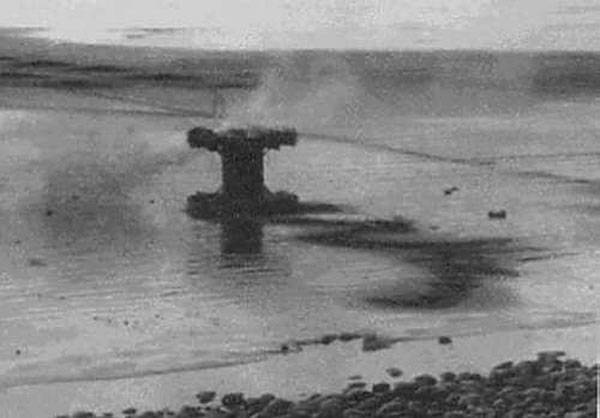
The result of an unsuccessful launch in January of 1944 g. A trace of a slid prototype is visible on the sand. Photo of Wikimedia Commons
The prototype was taken out of the water and equipped with new engines, increasing their number. With the gradual increase in the number of engines, several new launches were carried out. Certain results were obtained, but the task was still not solved. The Big Lump system could already reach the coast, but engine thrust and gained speed were still not enough to cross the beach, followed by a conditional defeat of the training target.
The first tests clearly showed that the proposed original idea, in general, is viable. However, it was not possible to obtain the required results for technical reasons. DMWD specialists returned home and continued their design work. By introducing certain changes, it was planned to get rid of the identified deficiencies, as well as to ensure effective defeat of the target. It took about three weeks to develop an improved version and build the second prototype of the Great Panjandrum jet propulsion system.
The design of the hull and wheels remained the same. Nevertheless, an additional mobile support appeared on the case, which is necessary for installing a small stabilizing wheel. Bearing could rotate relative to the body, because of what the third wheel always remained on the ground. The main reason for the problems with driving performance was considered to be an insufficiently powerful jet engine complex. In the updated design, four engines should fit on each wheel rim support. The wheel, respectively, now had 36 of such products, and the entire system as a whole - 72.

Great Panjandrum mock up from Dad's Army
At the end of September, the second prototype was delivered to the landfill, loaded onto the landing craft and delivered to the starting point. Engines successfully earned and rolled up the engineering charge from the carrier. Gradually accelerating, "Big Cuck" reached the shore. However, by that time some problems had appeared. Due to blows to the bottom or insufficiently strong construction, several engines fell off the mounts and scattered in different directions. After this, the product traveled a little along the beach, after which it collapsed to the side and, under the action of working engines, revolving, crawled back to the sea. This completion of the test could not be called successful.
The test showed that the third stabilizing wheel does not cope with its task, because of what it was removed. Soon they proposed a new method of stabilization in the course. He meant equipping the product with a set of special cables and fastenings with which it was possible to hold the product on the desired trajectory. It was proposed to use two cables wound on the central case or on the drum on the carrier: such a system would not allow a self-propelled charge to deviate strongly from the given direction.
During the week, DMWD experts led by N.Sh. Norway continued testing, experimenting with the power plant and the new control system. Different quantities and models of engines were tested, and cables of various thicknesses were tested. In the course of these works, we were again able to obtain some results, but the situation as a whole still did not look the best. So, the ammunition accelerated too much and simply cut off the thin cables. Fatter, in turn, could adversely affect acceleration or lead to other problems.
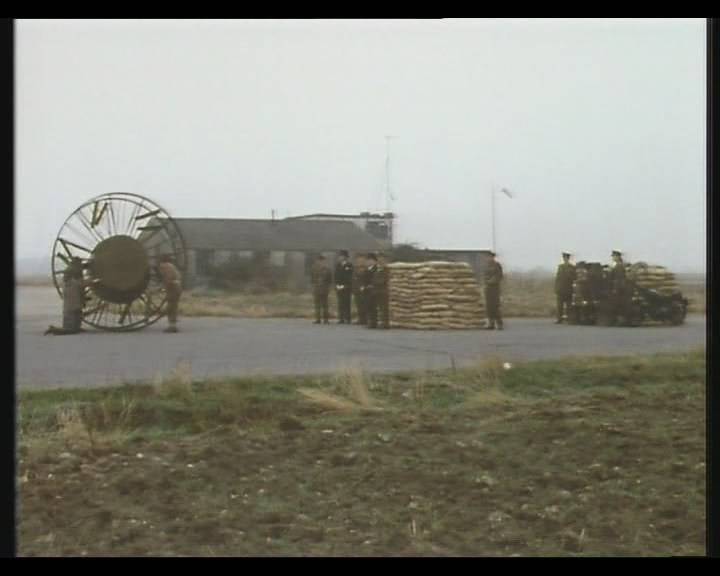
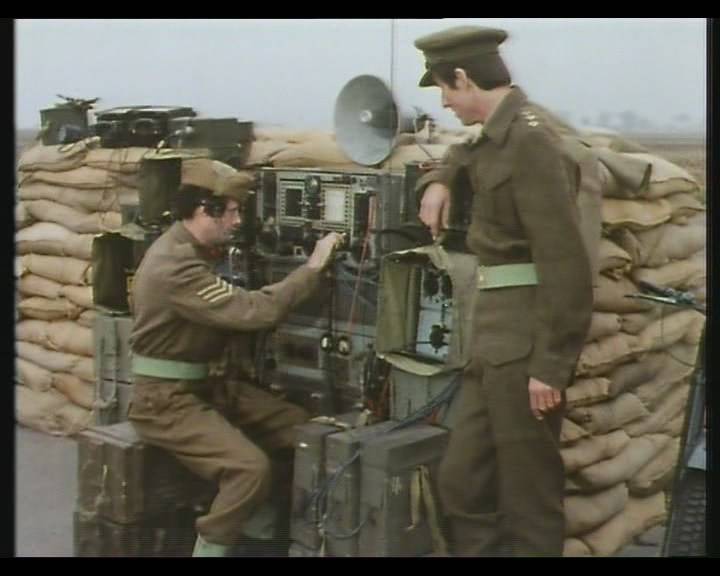

Tests of the HEAD PUFF system, shots from the cinema
After reviewing the current results of the Great Panjandrum project, the customer slightly modified the technical requirements to simplify them. Seeing the fundamental impossibility of achieving high accuracy of hitting, the military allowed to ensure only movement in the direction of the enemy. At the same time, the ammunition was still required to deliver the charge to the target, and not to return with it to the sea.
After a number of regular improvements and improvements, the Department of the development of a variety of weapons presented the latest version of the “Big Shot”. In January, 1944, the new prototype was delivered to the same landfill near Westward Ho. There was only one launch in the presence of representatives of the high command of the armed forces. Apparently, it was the presence of the leaders of the military department that determined the further fate of the original project.
As in the previous tests, Great Panjandrum successfully descended from the boat carrier and headed for the coast. Several rocket engines blew off the wheel again. Due to the difference in the prototype, it gradually began to turn to the right until it began to move in the direction of the cameraman, who was on the shore. Realizing that the situation is getting out of control, the high commission chose to quickly retire to shelter. The operator did not immediately understand what he was facing, but, fortunately, the prototype continued its right turn and managed to escape to the sea before anyone suffered. On a hummock, the product overturned and began to rotate, lying on its side. At the same time, the still-running engines fell off the mounts and flew away in all directions.
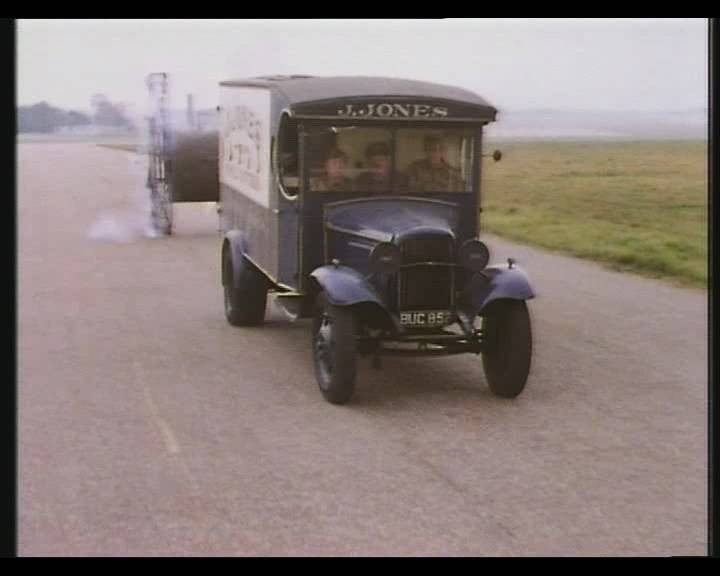
Chase...
It is unlikely that the result of such tests could be the respect of military leaders for an unusual project. Nevertheless, the impossibility of practical use of the Great Panjandrum was once again confirmed empirically. Even a few months after the start of the project and repeated modifications, the original weapon had too many flaws that could not be eliminated in principle. Due to the lack of real prospects, the project was closed. Existing prototypes went for disassembly as useless. Further development of engineering ammunition went on other ways.
After the war, the Great Panjandrum project was widely known enough and was repeatedly considered in different contexts. Perhaps the most interesting mention of this development is the merit of the BBC channel. In December, 1972, the next episode of the comedy television series Dad's Army entitled Round and Round Went the Great Big Wheel (directed by David Croft, screenplay - D. Croft and Jimmy Perry) came out. The “main hero” of this series was a new, promising weapon called the High Explosive Attack Device Propelled by Ultra-High Frequency or HEAD PUFF, which in Russian translation was transmitted as “Ultra-high frequency spinning reinforced cruel attacking tool” or KUCHA HORROR. The militia fighters, to whom the entire television series is dedicated, were brought to secret trials as auxiliary personnel, but something went wrong, and they had to save the project, and with it their hometown.
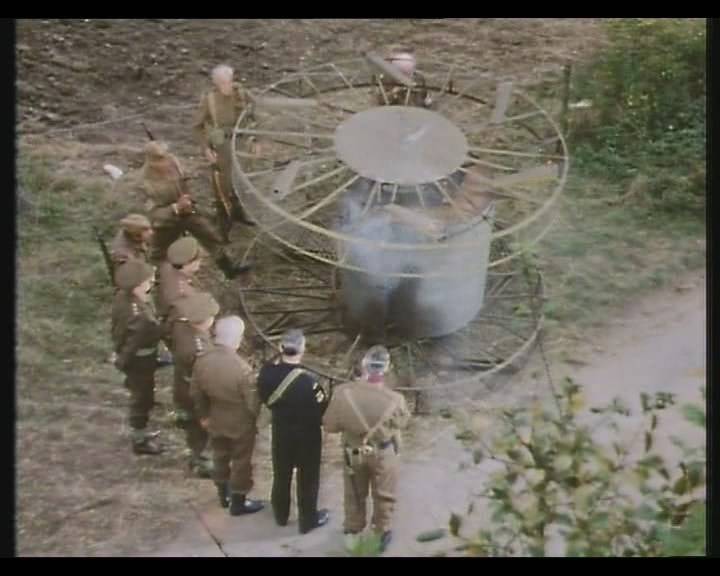
Monster down
The serial HEAD PUFF product was significantly different from the real prototype. It had more complex wheels with a smaller number of engines, which, moreover, could stop and start at the command of onboard automation. Instead of a stationary relative to the wheels of the central body, a hinged cylinder was used, which retains its position when moving. Finally, the cinematic weapon was radio controlled. Of course, because of all this, HEAD PUFF and “Big Boot” had only some external similarity, but the differences made it possible to get a very interesting plot with a large share of insanity peculiar to the original real project.
In June 2009 of the year, during the celebration of the 65 anniversary of the landing in Normandy, the organizers of the festival Appledore Book Festival presented their version of the reconstruction of “Big Shot”. At their request, the pyrotechnic company Skyburst built a similar product. It differed from the original in a slightly different arrangement, covered with wheels on the side and lower weight due to the absence of a warhead. The launch of the replica took place on the same beach, which was a testing ground several decades ago. It was assumed that the new "weapon" will be able to accelerate to 24-25 km / h and drive around 500 m, but the actual range was ten times less. Although it must be admitted that pyrotechnics made this short trip very spectacular and incendiary.
The Great Panjandrum project was based on the desire of the military to obtain a relatively simple and effective means of dealing with enemy concrete structures and fortifications, which allowed them not to subject their personnel to special risks. Specific and rather complex technical requirements had to be met by using more than original ideas. Nevertheless, as practice has shown, the proposed appearance of self-propelled engineering ammunition did not allow to count on successful practical application.
It should be noted that the lack of prospects for the finished product and the doubtfulness of the project even at the stage of the formation of technical requirements may be a reason for suspicion. There is a version according to which the project "Big Boot" was created solely as a means of misinforming the enemy. Information about a cheap, simple and powerful means of dealing with fortifications could provoke Hitler Germany to those or other actions that could adversely affect its protection. This version does not have serious confirmations, but it can still explain a lot.
Anyway, throughout the Second World War, the defense industry of Great Britain tried to create new types of weapons and equipment. Some of these developments went into series, while others did not go beyond the limits of polygons. Great Panjandrum engineering ammunition, for objective reasons, could not get to the troops and take part in real battles, but this does not make it less interesting in terms of technology and stories.
Based on:
https://weaponsandwarfare.com/
http://iwm.org.uk/
http://timesonline.co.uk/
Johnson, B. The Secret War. Pen & Sword. 2004.
- 1: 57
"Big Shot" at the Appledore Book Festival:
Episode of the series Dad's Army, Round and Round Went the Great Big Wheel:
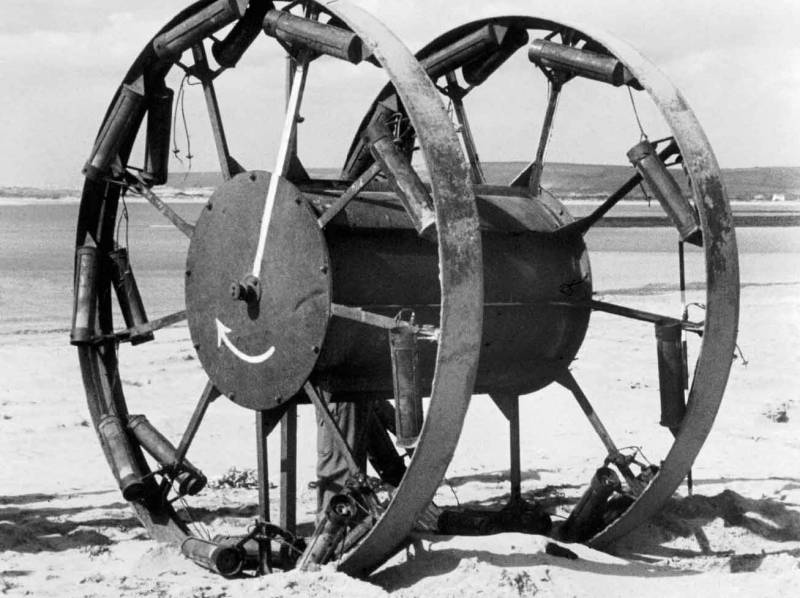
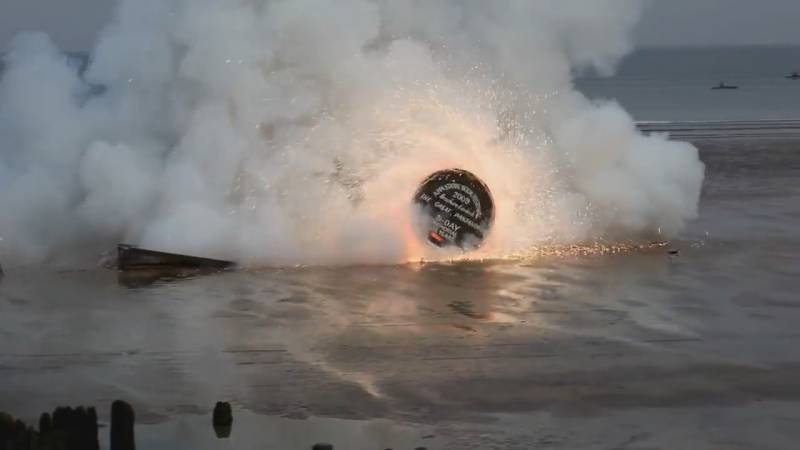
Information